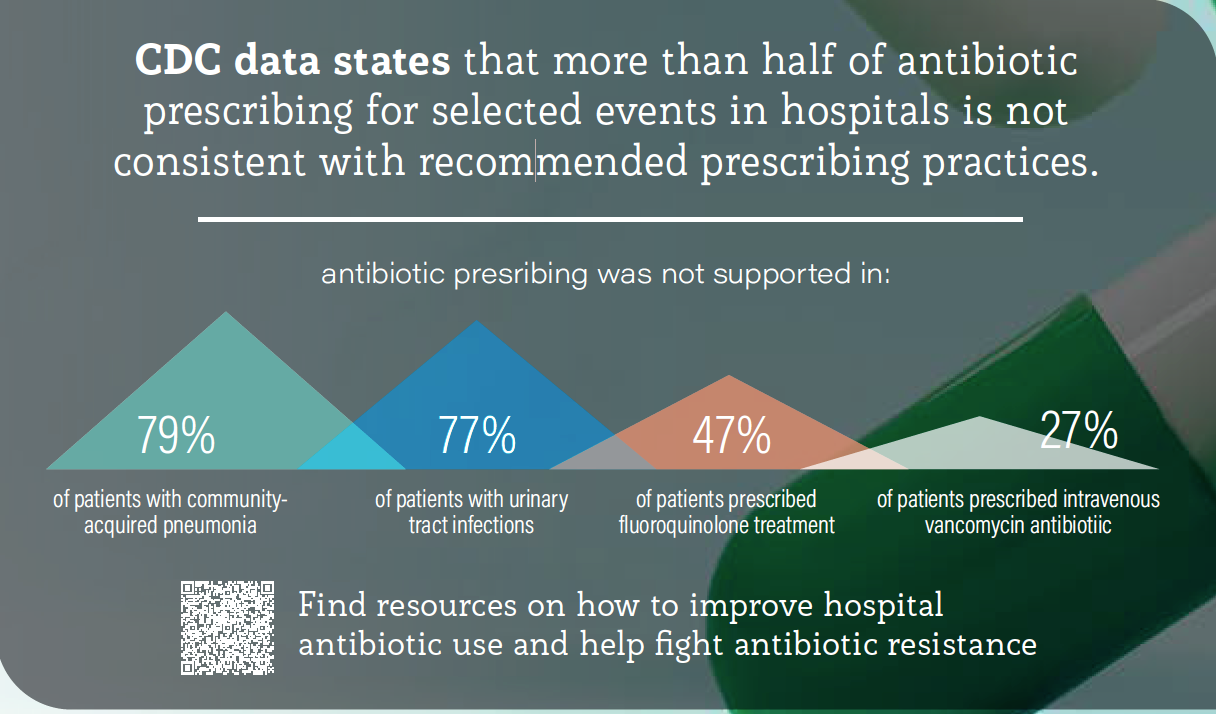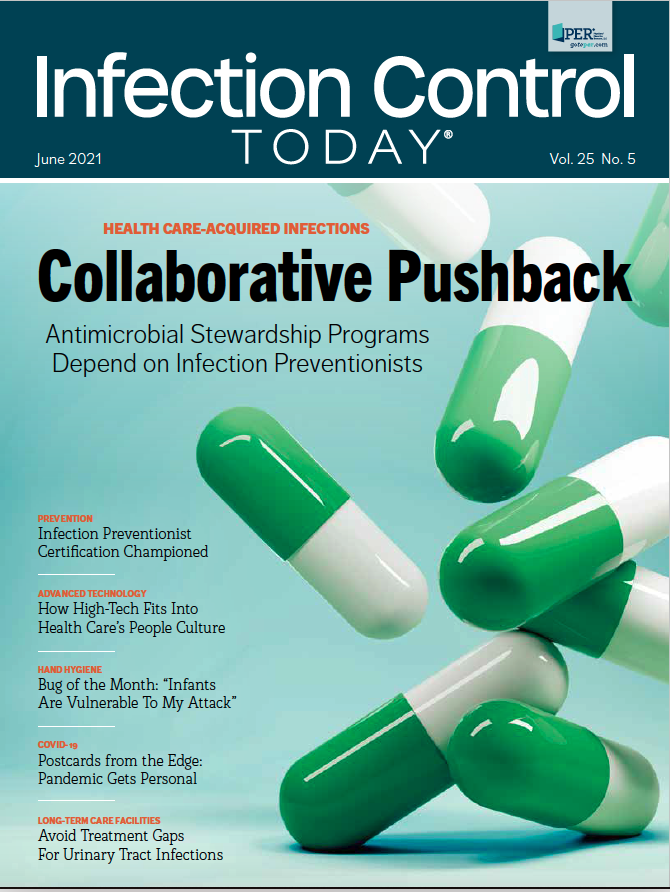IPs Play Hidden Role in Antimicrobial Stewardship Programs
The increasing threat of antimicrobial resistance, exacerbated by the pandemic, underscores the importance of the infection preventionist as an active member of the antimicrobial stewardship program.
Antimicrobial resistance is a worldwide concern, as evidenced by the World Health Organization (WHO) declaring it a top 10 global health issue.1 The Centers for Disease Control and Prevention (CDC) estimates that 2.8 million infections per year are caused by resistant organisms.2 Additionally, investigators of a recent study concluded that antimicrobial-resistant infections cost the United States approximately $4.6 billion annually.3 A human cost exists also in terms of the inability to perform responsibilities or fulfill roles at work, home, and in the community. Sadly, almost 36,000 Americans lose their lives annually as a result of infections caused by organisms that are not susceptible to the antimicrobials typically used to treat such infections.2
The COVID-19 pandemic has also spurred an increase of infections caused by antibiotic-resistant organisms. This phenomenon is due to several factors, including the shifting of resources away from routine infection surveillance and prevention activities as well as increased antimicrobial prescribing to prevent secondary infections.4,5
Luci Perri, MSN, MPH, RN, CIC, FAPIC, CSPDT

Antimicrobial resistance has been viewed as such an urgent need that the Centers for Medicare & Medicaid Services (CMS) and the Joint Commission developed standards to spur the development and/or progress of antimicrobial stewardship programs in hospitals and nursing homes. These standards have been in effect for several years albeit somewhat unevenly, even in the same types of facilities. Rural and small hospitals are less likely to have a program, whereas programs in nursing homes, if implemented at all, are in their infancy.6 Although both the CMS and Joint Commission cite standards that indicate an expectation for the infection preventionist (IP) to participate in antimicrobial stewardship efforts, the role is poorly defined.
The CDC Core Elements of Antibiotic Stewardship programs offer some insight into the role of the IP in the program in acute care facilities, small and critical access hospitals, nursing homes, and the outpatient setting.7-10 According to the CDC, 3 types of infection are associated with the majority of antibiotic use in hospitals, including rural and critical access hospitals: urinary tract infection (UTI), community-acquired pneumonia (CAP), and skin and soft tissue infections.7,10 IPs are well acquainted with care bundles to prevent UTI, which include determining whether a urethral catheter is needed prior to insertion and, if needed, to reevaluate the need daily. The IP is frequently involved with educating staff and physicians and with audits to determine whether such a device is needed. This exemplifies the supporting role of the IP in the antimicrobial stewardship program: that of prevention. If infections don’t occur, there is no need for treatment. IPs can prioritize the prevention activities that coincide with the focus of the antimicrobial stewardship program and, as always, the universal preventive activity: hand hygiene.
In addition to prevention activities, reporting infection surveillance data, including multidrug-resistant organisms, to the antimicrobial stewardship team can help to inform decisions about which antibiotics to target or which physician groups to educate or advise on antibiotic usage.
Likewise, reporting process surveillance data to the team, such as on hand hygiene, can also help to inform decisions.
Although it may be more exciting to be able to report decreased health care–acquired infections (outcome measures) due to the antimicrobial stewardship program, a rapid and dramatic decrease because of changes in antimicrobial prescribing practices is unlikely. Seeing a change in outcome measures will probably take a while if a facility has relatively low infection rates. However, changes in practice (process measures) may provide a more realistic reporting statistic, as improvement in these numbers may occur more rapidly than actual numbers of infections. Practice modifications contribute to the overall success of the antimicrobial stewardship program, which is to prevent the increase of resistant organisms and resultant decrease in effective treatment choices.
The infection prevention risk assessment and annual plan can serve as a jumping-off point to spur collaboration between the infection prevention program and the antimicrobial stewardship program. For example, if Clostridioides difficile is a priority, work with the antimicrobial stewardship team to create a plan that includes the best evidence-based practice to support the goal. Be sure to include actions for nursing services personnel, such as prompt isolation of patients with diarrhea not attributed to medications or chronic conditions.
Education
The IP can also play a role in educating nurses and physicians. According to the literature, nurses frequently initiate a request for urine cultures that may not always be appropriate and can contribute to treatment of asymptomatic bacteriuria.11-13 In the nursing home environment, the IP can be key in reducing urine culture collection by assisting with the implementation of the Loeb Minimum Criteria for Initiation of Antibiotics in Long-Term Care Residents,14 which the Agency for Healthcare Research and Quality (AHRQ) has operationalized into an internet-based tool.15 Printable and web-based tools for the top 3 infections are available through AHRQ as part of a nursing home antimicrobial stewardship toolkit. Other toolkits are available on their website, including the Community-Acquired Pneumonia Clinical Decision Support Implementation Toolkit (https://bit.ly/3xLTpOH) for ambulatory sites and the Acute Care Hospital Toolkit for antibiotic stewardship (https://bit.ly/3thabBX). The toolkits can be used as a starting point to educate and collaborate with stakeholders to change practice and decrease unnecessary cultures.
IPs can add to the breadth of the stewardship program by collaborating with the team to develop education to support the goals of both the infection prevention and the antimicrobial stewardship program. Because IPs are frequently on the units, they can educate staff and physicians a little at a time. This would allow everyone time to get used to an idea, and to formulate questions that may uncover obstacles to implementing the change in practice. This approach may prove quite helpful as, invariably, some staff have been practicing for some time and may not see a need to change or need time to adjust to imminent change.
During rounding, the IP can speak with staff to explain the antimicrobial stewardship program, including why it is important, how it intersects the infection prevention program, the importance of staff practice, and the staff’s role in both programs. When speaking with nurses, consider emphasizing the nurses’ role in patient advocacy because implementing processes to reduce infections and antibiotic usage benefits the patient and is a major contributor to patient safety.
At some point, the stewardship program may find a need to develop clinical algorithms, craft order sets, or design order entry to limit antibiotic use. These opportunities permit the IP to contribute to the team’s efforts while keeping the goals of the infection prevention program in mind and ensuring these pursuits are consistent with infection prevention principles and practice.
Another contribution IPs can make is to register with the health department to receive alerts. This enables them to remain informed of infectious agents of concern circulating in the local area and of local or regional outbreaks, as admitted patients could bring those same pathogens into the facility. Such information will benefit the entire team as they will know beforehand which organisms of concern might be brought into the facility. This advance knowledge will allow the team to develop a feasible plan of action, including appropriate antibiotics, before patients (and pathogens) arrive.
Bottom Line
IPs are an integral member of the antimicrobial stewardship team. That may not always be evident because the activities IPs routinely perform through infection prevention programs can be difficult to connect to antimicrobial stewardship programs because they don’t prescribe antimicrobials. However, IPs shouldn’t assume that their only role is to point out culture susceptibility or resistance mismatches; rather, they should bask in the knowledge that their routine activities benefit patients by reducing the number of infections and by contributing to the stewardship program to help ensure effective antimicrobials are available when needed.
Source: Centers for Disease Control and Prevention

LUCI PERRI, MSN, MPH, RN, CIC, FAPIC, CSPDT, is the owner and president of Infection Control Results, a full-service infection control consulting company. She travels throughout the country to assist acute care and long-term care facilities as well as dental and medical practices and clinics to improve practice, which ultimately protects patients.
REFERENCES:
- 10 global health issues to track in 2021. World Health Organization. December 24, 2020. Accessed April 24, 2021. https://www.who.int/news-room/spotlight/10-global-health-issues-to-track-in-2021
- Antibiotic resistance threats in the United States, 2019. CDC. 2019. Accessed April 24, 2021. http://dx.doi.org/10.15620/cdc:82532.
- Nelson RE, Hatfield KM, Wolford H, et al. National estimates of healthcare costs associated with multidrug-resistant bacterial infections among hospitalized patients in the United States. Clin Infect Dis. 2021;72(suppl 1):S17-S26. doi:10.1093/cid/ciaa1581
- Rawson TM, Moore LSP, Zhu N, et al. Bacterial and fungal coinfection in individuals with coronavirus: a rapid review to support COVID-19 antimicrobial prescribing. Clin Infect Dis. 2020;71(9):2459-2468. doi:10.1093/cid/ciaa530
- Strathdee SA, Davies SC, Marcelin JR. Confronting antimicrobial resistance beyond the COVID-19 pandemic and the 2020 US election. Lancet. 2020;396(10257):1050-1053. doi:10.1016/S0140-6736(20)32063-8
- Pollack LA, van Santen KL, Weiner LM, Dudeck MA, Edwards JR, Srinivasan A. Antibiotic stewardship programs in U.S. acute care hospitals: findings from the 2014 National Healthcare Safety Network Annual Hospital Survey. Clin Infect Dis. 2016;63(4):443-449. doi:10.1093/cid/ciw323
- Core Elements of Hospital Antibiotic Stewardship Programs. CDC. Updated April 28, 2021. Accessed April 24, 2021. http://www.cdc.gov/getsmart/healthcare/implementation/core-elements.html
- Sanchez GV, Fleming-Dutra KE, Roberts RM, Hicks LA. Core elements of outpatient antibiotic stewardship. MMWR Recomm Rep. 2016;65(6):1-12. doi:10.15585/mmwr.rr6506a1
- Core Elements of Antibiotic Stewardship for Nursing Homes. CDC. Accessed April 24, 2021. https://www.cdc.gov/longtermcare/prevention/antibiotic-stewardship.html
- Implementation of antibiotic stewardship core elements at small and critical access hospitals. CDC. Updated February 6, 2020. Accessed April 24, 2021. https://www.cdc.gov/antibiotic-use/core-elements/small-critical.html#intro
- Sloane PD, Kistler CE, Reed D, Weber DJ, Ward K, Zimmerman S. Urine culture testing in community nursing homes: gateway to antibiotic overprescribing. Infect Control Hosp Epidemiol. 2017;38(5):524-531. doi:10.1017/ice.2016.326
- Jones K, Sibai J, Battjes R, Fakih MG. How and when nurses collect urine cultures on catheterized patients: a survey of 5 hospitals. Am J Infect Control. 2016;44(2):173-176. doi:10.1016/j.ajic.2015.09.003
- Garcia R, Spitzer ED. Promoting appropriate urine culture management to improve health care outcomes and the accuracy of catheter-associated urinary tract infections. Am J Infect Control. 2017;45(10):1143-1153. doi:10.1016/j.ajic.2017.03.006
- Loeb M, Bentley DW, Bradley S, et al. Development of minimum criteria for the initiation of antibiotics in residents of long-term-care facilities: results of a consensus conference. Infect Control Hosp Epidemiol. 2001;22(2):120-124. doi:10.1086/501875
- Minimum Criteria for Antibiotics Tool. AHRQ. Updated September 2017. Accessed April 25, 2021. https://www.ahrq.gov/nhguide/toolkits/determine-whether-to-treat/antibiotic-tool.html

Newsletter
Stay prepared and protected with Infection Control Today's newsletter, delivering essential updates, best practices, and expert insights for infection preventionists.
259 Prospect Plains Rd, Bldg H,
Cranbury, NJ 08512